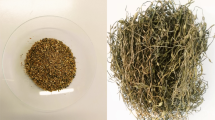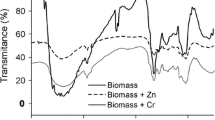Abstract
Nonliving waste biomass consisting of Aspergillus niger attached to wheat bran was used as a biosorbent for the removal of copper and zinc from aqueous solutions. Copper and zinc uptake by the biomass obeyed Langmuir isotherms. The binding capacity of the biomass for copper was found to be higher than that for zinc. The metal uptake, expressed in milligrams per gram of biomass, was found to be a function of:
-
the initial metal concentration (with the uptake decreasing with increasing initial concentration),
-
the biomass loading (with the uptake decreasing with increasing biomass loading) and
-
pH (with the uptake increasing with increasing pH in the range of 1.5 and 6.0).
The metal uptake was significantly affected in the presence of a co-ion. The uptake of copper by the biomass decreased in the presence of zinc and vice versa. The decrease in metal uptake was dependent on the concentrations of metals in the two-component aqueous solutions. The effect of copper on zinc uptake was more pronounced than the effect of zinc on copper uptake.
Similar content being viewed by others
Explore related subjects
Discover the latest articles, news and stories from top researchers in related subjects.References
Balakrishnan, M., Modak, J.M., Natarajan, K.A., and Naik, J.S.G., 1994, “Biological uptake of precious and base metals from gold-process cyanide effluents,” Mine and Metall. Proc., in print.
De Rome, L., and Gadd, G.M., 1987, “Copper adsorption by Rhizopus arrhizus, Cladosporium resinae and Penicillium italicum,” Appl. Microbiol. Biotechnol., 26, pp. 84–90.
Failla, M.L., Benedict, C.D., and Weinberg, E.D., 1976. Accumulation and storage of Zn by Candida utilis,” J. Gen. Microbiology, 94, pp. 23–26.
Farkas, V., 1980, “Biosynthesis of cell walls of fungi,” Microbiol. Rev., 44, pp. 117–141.
Fourest, E., and Roux, J.C., 1992, “Heavy metal biosorption by fungal mycelial by-products: mechanisms and influence of pH,” Appl. Microbiol. Biotechnol., 37, pp. 399–403.
Gadd, G.M., and Mowll, H., 1985, “Copper uptake by yeastlike cell, hypae and chlamy-dospores of Aureobasidium pullulans,” Exp. Mycol., 9, 230–240.
Harris P.O., and Ramelow, G.J., 1990, “Binding of metal ions by particulate biomass derived from Chlorella vulgaris and Scenedesmus quadricauda,” Environ. Sci. Technol., 24, pp. 220–228.
Itoh, M., Yuasa, M., and Kobayashi, T., 1975, “Adsorption of metal ions on yeast cells at varies cell concentrations,” Plant Cell Physio., 16, pp. 1167–1169.
Langmuir, I., 1918, “The adsorption of gases on plane surfaces of glass, mica and platinum, J. Am. Chem. Soc., 40, pp. 1361–1403.
Luef, L., Prey, T., and Kubicek, C.P., 1991, “Biosorption of zinc by fungal mycelial wastes,” Appl. Microbiol and Biotechnol, 34, pp. 688–693.
Pons, M.P., and Fuste, C.M., 1993, “Uranium uptake by immobilized cells of Pseudomonas strain EPS 5028,” Appl. Microb. Biotech., 39, pp. 661–665.
Rosenberger, L., 1975, “The cell wall,” The Filamentous Fungi, Vol 2, J.F. Smith and D.R. Berry, eds., Edward Arnold, London, pp. 328–343.
Ross, I.S., and Townsley, C.C., 1986, “The uptake of heavy metals by filamentous fungi,” Immobilization of Ions by Biosorption, M. Eccles and S. Hunt, eds., Ellis Horwood, Chichester, pp. 49–58.
Sakaguchi, T., and Nakajima, A., 1991, “Accumulation of heavy metals such as Uranium and Thorium by microorganisms,” Mineral Bioprocessing, R. Smith and M. Misra, eds., TMS, Warrendale, pp. 309–322.
Tobin, J.M., Copper, D.G., and Neufeld, R.J., 1984, “Uptake of metal ions by Rhizopus arrihizus biomass,” App. Env. Microbiol., 47, pp. 821–824.
Townsley C.C., and Ross, I.S., 1986, Copper uptake in Aspergillus niger during batch growth and in nongrowing mycelial suspensions,” Exper. Mycol., 10, pp. 281–288.
Tsezos, M., and Volesky, B., 1981, Biosorption of uranium and thorium, Biotechnol. Bioeng., 23, pp. 583–604.
Zhou, J.L., and Kiff, R.J., 1991, “The uptake of copper from aqueous solution by immobilized fungal biomass,” J. Chem. Tech. Biotechnol., 52, pp. 317–340.
Author information
Authors and Affiliations
Additional information
SME nonmeeting paper 95–630. Discussion of this peer-reviewed and approved paper is invited and must be submitted, in duplicate, prior to Aug. 30, 1996.
Rights and permissions
About this article
Cite this article
Modak, J.M., Natarajan, K.A. & Saha, B. Biosorption of copper and zinc using waste Aspergillus niger biomass. Mining, Metallurgy & Exploration 13, 52–57 (1996). https://doi.org/10.1007/BF03402718
Received:
Revised:
Published:
Issue Date:
DOI: https://doi.org/10.1007/BF03402718




